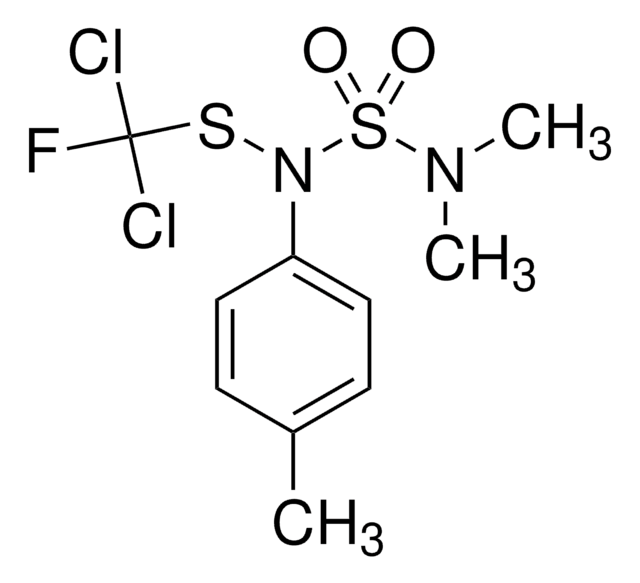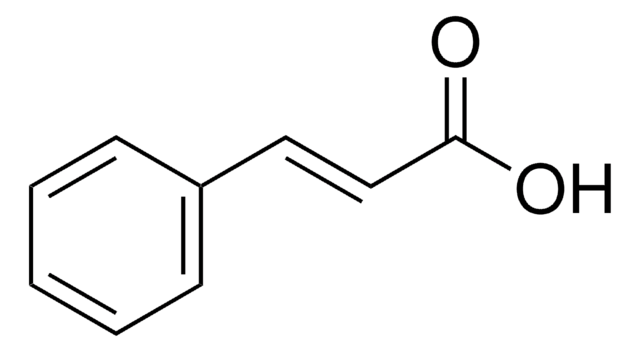추천 제품
Grade
analytical standard
Quality Level
vapor density
6.5 (vs air)
vapor pressure
<1 mmHg ( 20 °C)
분석
≥98.5% (GC)
유통기한
limited shelf life, expiry date on the label
기술
HPLC: suitable
gas chromatography (GC): suitable
불순물
≤0.5% water
bp
286 °C/100 mmHg (lit.)
mp
106-112 °C
109-111 °C (lit.)
응용 분야
cleaning products
cosmetics
flavors and fragrances
food and beverages
personal care
형식
neat
SMILES string
OC(=O)CCCCCCCC(O)=O
InChI
1S/C9H16O4/c10-8(11)6-4-2-1-3-5-7-9(12)13/h1-7H2,(H,10,11)(H,12,13)
InChI key
BDJRBEYXGGNYIS-UHFFFAOYSA-N
유사한 제품을 찾으십니까? 방문 제품 비교 안내
일반 설명
Azelaic acid (heptane-l,7-dicarboxylic acid), a dicarboxylic saturated acid, is an active component of some topical anti-acne preparations. It is reportedly identified in cosmetics and pharmaceuticals. Azelaic acid is found to suppress the growth of Propionibacterium spp. and reduce keratinization.
This substance is listed on the positive list of the EU regulation 10/2011 for plastics intended to come into contact with food. Find all available reference materials for compounds listed in 10/2011 here
애플리케이션
Azelaic acid may be used as an analytical reference standard for the quantification of the analyte in the following:
- Tobacco using gas chromatography coupled to mass spectrometry (GC-MS).
- Topical preparations using reversed-phase liquid chromatographic (LC) with UV-Vis detection.
Refer to the product′s Certificate of Analysis for more information on a suitable instrument technique. Contact Technical Service for further support.
신호어
Warning
유해 및 위험 성명서
Hazard Classifications
Eye Irrit. 2 - Skin Irrit. 2
Storage Class Code
11 - Combustible Solids
WGK
WGK 1
Flash Point (°F)
410.0 °F - closed cup
Flash Point (°C)
210 °C - closed cup
이미 열람한 고객
Simultaneous determination of azelaic and benzoic acids in topical preparations by liquid chromatography
Mansour MA and Ibrahiem MM
Chromatographia, 55(7-8), 435-437 (2002)
James Q Del Rosso
Cutis, 77(2 Suppl), 22-24 (2006-03-29)
Topical azelaic acid (AzA) is approved for the treatment of acne vulgaris and inflammatory (papulopustular) rosacea. Because of diverse mechanisms of action that correlate with potential therapeutic benefit, AzA has been used to treat several common dermatoses including acne vulgaris
Boni Elewski et al.
Cutis, 77(2 Suppl), 12-16 (2006-03-29)
Azelaic acid (AzA) initially was released in a 20% cream formulation, which has been shown to be effective in the treatment of mild to moderate rosacea. Recently, a 15% gel formulation was developed that vastly improved the delivery of AzA
James E Frampton et al.
American journal of clinical dermatology, 5(1), 57-64 (2004-02-26)
Azelaic acid is a naturally occurring, straight-chain dicarboxylic acid which is effective in the treatment of rosacea, presumably on account of its anti-inflammatory properties. In randomized, double-blind, multicenter studies involving patients with moderate papulopustular facial rosacea, twice-daily topical application of
P S Mackrides et al.
American family physician, 54(8), 2457-2459 (1996-12-01)
Azelaic acid is another option for the topical treatment of mild to moderate inflammatory acne vulgaris. It offers effectiveness similar to that of other agents without the systemic side effects of oral antibiotics or the allergic sensitization of topical benzoyl
자사의 과학자팀은 생명 과학, 재료 과학, 화학 합성, 크로마토그래피, 분석 및 기타 많은 영역을 포함한 모든 과학 분야에 경험이 있습니다..
고객지원팀으로 연락바랍니다.











